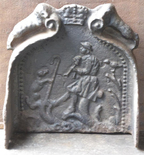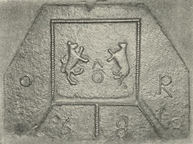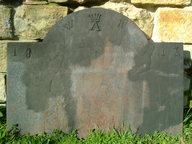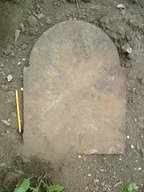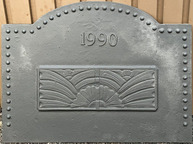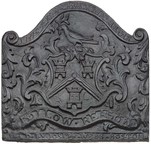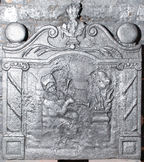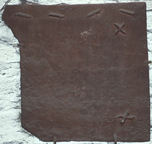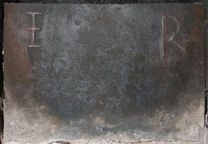-
1128
Description: Quasi-arched shape with forward-facing 'wings', which splay outwards towards the base; the 'wings' curve to follow the shape of the main panel but curl outwards at the top; central panel with pictorial image of, to the right, a shepherd holding a musical pipe, his right foot upon a log, upon which a dog, to the left, sits holding the shepherd's crook; top centre, a crown, on either side of which, on the curled upper parts of the 'wings', is an inward facing sheep.
Notes: Nothing is known about the sources of free-standing firebacks or what prompted their production. Their form is similar but the predominant use of horticultural or arboreal decorative themes, which suggests production within a limited time frame, has in this instance been replaced with a humorous scene. Only a very small number of such castings are known. Depth 210mm
- Decoration tags:
- free-standing (shape)
- none (edging)
- whole carved pattern
- heraldic
- pictorial
- animals
- humans
- plants
- objects
Manufactured: in the late-17th to early-18th century in England.
Current location: not known.
- Attached to series:
- Free-standing firebacks
-
897
Description: Steeply canted rectangle; no edging; upper centre, square formed of twisted rope lengths inside which are what appear to be two lions passant in pale with a circle and two short sloping lines in inverted V form above; on either side of the square is an O and an R; below the square three lengths of twisted rope extend to the bottom edge, the central one vertically and the the outer two sloping away from the centre; along the bottom is the date, each numeral separated by one of the rope lengths.
Notes: Alleged to be a representation of the arms of the O'Rourke family, who held sway in Cavan and Leitrim, the initials said to be of Owen O'Rourke. Noted in a cottage at Arigna, County Roscommon.
Inscription: O O R / 1 6 8 8
Arms: O'Rourke
- Decoration tags:
- rectangular with canted top corners (shape)
- none (edging)
- simple stamps
- carved stamps
- heraldic
- text
- animals
- objects
Manufactured: in 1688 possibly at Drumshanbo Furnace in the Leitrim area of Ireland.
Current location: not known.
Citation: Lindsay, J. S., 1927, Iron & Brass Implements of the English House (London, The Medici Society).
- Attached to series:
- Miscellaneous stamp firebacks
- Date & initials firebacks
-
14
Description: Arched rectangular shape; plain plate. Crowned capital ‘A’ between ‘W’ and ‘R’; divided date at top extremities of plate; single six-pointed star below ‘A’.
Notes: Earl’s coronet denotes the Earl of Ashburnham, furnace owner; ‘WR’ denotes William Rummins, furnace founder; 1813 - the furnace was blown out for the last time in late February 1813. Similar to, but narrower than the fireback at Church Farm, Penhurst (in private hands), and uses the same cipher and numbers. One of a small series of firebacks cast in the early-19th century for farms on the Ashburnham estate; this example was formerly at Great Sprays Farm, Penhurst.
Inscription: W A R / 18 * 13
- Decoration tags:
- rectangular with round arch (shape)
- none (edging)
- carved stamps
- individual letters
- individual numbers
- heraldic
- text
- objects
Manufactured: in 1813 at Ashburnham Furnace in the Weald area of England.
Current location: in private hands, Ashburnham, East Sussex, England.
- Attached to series:
- Ashburnham late series
- Date & initials firebacks
-
15
Description: Arched rectangular shape; no edging.
Notes: The plain form suggests a common source with firebacks cast at Ashburnham in 1813. One of a small series of firebacks cast in the early-19th century for farms on the Ashburnham estate.
- Decoration tags:
- rectangular with round arch (shape)
- none (edging)
Manufactured: in the early-19th century probably at Ashburnham Furnace in the Weald area of England.
Current location: in private hands, Ashburnham, East Sussex, England.
- Attached to series:
- Ashburnham late series
- Base boards
-
1270
Description: Arched rectangular shape; plain edge with 49 large beads parallel with top and sides; upper centre, date in bold Arabic numerals; below date, raised rectangular panel with chamfered sides and corners and fillet edging, and a symmetrical sunburst and rainbow design in low relief.
Notes: Modern, quasi-Art Deco design
Inscription: 1990
- Decoration tags:
- rectangular with round arch (shape)
- none (edging)
- whole carved pattern
- individual numbers
- text
- objects
Manufactured: in 1990 in England.
Current location: in private hands Bedford, Bedfordshire, England.
- Attached to series:
- Miscellaneous pattern firebacks
- 1990s Art Deco series
-
1080
Description: Cast-iron fireback consisting of a panel with an arched top and scrolled ears. Decorated with reliefs, foliate borders at the sides, and in the centre with a coat of arms consisting of a shield, three castles separated by a chevron with an open compass, and with crest of a bird with a leafed branch in its beak, all elaborated with foliage. Motto along arched crest; motto in scroll below arms; maker’s name along bottom.
Notes: The arms are essentially those of the Premier Grand Lodge of England, granted in 1717, differenced by the motto; the Massachusetts Lodge was founded in 1733; the blazon is an adaptation of the arms of the Worshipful Company of Masons. Joseph Webb was a Boston ironmonger and chandler; his 1765 trade card was designed by fellow Freemason Paul Revere, who may also have cast the fireback.
Copies of this fireback are known.
Inscription: THE • FREE • MASONS • ARMS / FOLLOW • REASON / SOLD • BY • JOSEPH • WEBB • BOSTON
Arms: Massachusetts Grand Lodge of Freemasons
- Decoration tags:
- rectangular with round arch (shape)
- none (edging)
- whole carved pattern
- heraldic
- armorial
- text
Manufactured: in the mid- to late-18th century probably at North End Ironworks, Boston in the Massachusetts area of United States of America.
Current location: Museum of Fine Arts, Boston, Massachusetts, United States of America.
Museum number: 1982.618 (part of the Boston Museum of Fine Arts museum group)
- Attached to series:
- Personal armorial firebacks
-
1268
Description: Quasi-arched shape with forward-facing 'wings', which splay outwards towards the base; the 'wings' curve to follow the shape of the main panel but curl outwards at the top; central panel with stylised image of a tree; top centre, three ostrich feathers gathered at their quills, on either side of which, on the curled upper parts of the 'wings', are a mirrored feature of uncertain type.
Notes: Nothing is known about the sources of free-standing firebacks or what prompted their production. Their form is similar and the predominant use of horticultural or arboreal decorative themes suggests production within a limited time frame. Only a very small number of such castings are known. Depth 210mm. The fireback has been repaired in the main panel and attached to a later grate.
- Decoration tags:
- free-standing (shape)
- none (edging)
- whole carved pattern
- plants
- objects
Manufactured: in the late-17th to early-18th century in England.
Current location: Bramshill House, Bramshill, Hampshire, England.
- Attached to series:
- Free-standing firebacks
-
27
Description: Arched rectangular shape with symmetrical scrolled ‘portico’ above, a flower vase between and circular discs at each end, symmetrical horizontal palm fronds below; pilaster with spiral design and Ionic capital on each side; central pictorial scene of a bagpiper with Elizabethan ruff and soft cap with feather in front of a vaulted ruin, on the right a flaming cauldron on a plinth.
Notes: This seems to be pastiche using various elements derived from other firebacks, notably the moulding and scrolled top are from the Lenard fireback , and the palm fronds are from elsewhere. The figure may be adapted from a painting of a bagpiper by Abraham Bloemaert (1564-1651).
Copies of this fireback are known.
- Decoration tags:
- rectangular with ornate arch (shape)
- none (edging)
- whole carved pattern
- pictorial
- humans
- objects
Manufactured: in England.
Current location: Bateman's, Burwash, East Sussex, England.
Museum number: 761118 (part of the National Trust museum group)
- Attached to series:
- British 'Dutch' style firebacks
-
31
Description: Fragment; rectangular plate with series of parallelogrammatic billets arranged across the top; crossed billets in corners
- Decoration tags:
- rectangular (shape)
- none (edging)
- simple stamps
Manufactured: possibly in the Weald area of England.
Current location: in private hands Burwash, East Sussex, England.
- Attached to series:
- Miscellaneous stamp firebacks
-
221
Description: Rectangular; plain plate; inscription in capitals split between top corners, ‘I’ crossed.
Notes: The letters are likely to have been formed by tracing their shape in the casting sand using a pointed implement.
Inscription: I R
- Decoration tags:
- rectangular (shape)
- none (edging)
- individual letters
- text
Manufactured: in the early-17th century in the Weald area of England.
Current location: in private hands, Buxted, East Sussex, England.
- Attached to series:
- Initials only firebacks
